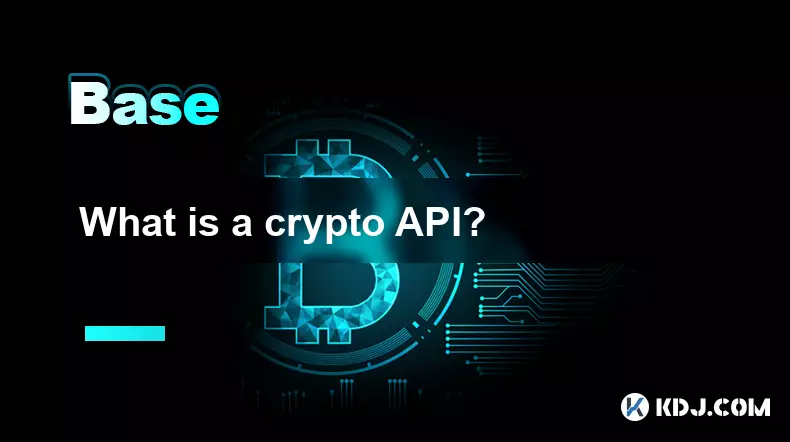-
 bitcoin
bitcoin $87706.997328 USD
2.23% -
 ethereum
ethereum $2845.033150 USD
1.23% -
 tether
tether $0.999595 USD
0.02% -
 xrp
xrp $2.074054 USD
3.48% -
 bnb
bnb $846.140045 USD
0.19% -
 solana
solana $132.574402 USD
2.19% -
 usd-coin
usd-coin $0.999795 USD
0.03% -
 tron
tron $0.276369 USD
0.57% -
 dogecoin
dogecoin $0.146864 USD
3.51% -
 cardano
cardano $0.413357 USD
1.25% -
 bitcoin-cash
bitcoin-cash $555.623837 USD
1.32% -
 hyperliquid
hyperliquid $32.859432 USD
5.18% -
 zcash
zcash $574.673847 USD
-1.35% -
 chainlink
chainlink $12.654621 USD
2.52% -
 unus-sed-leo
unus-sed-leo $9.467473 USD
0.30%
What is a crypto API?
Crypto APIs bridge blockchain networks and apps, enabling developers to securely access real-time data, interact with smart contracts, and build scalable dApps without running full nodes.
Sep 12, 2025 at 09:18 am

Understanding the Role of Crypto APIs in Blockchain Ecosystems
1. A crypto API, or cryptocurrency application programming interface, serves as a bridge between blockchain networks and external applications. It enables developers to interact with blockchain data without running their own nodes. By sending HTTP requests, applications can retrieve transaction details, check wallet balances, and broadcast new transactions.
2. These APIs are essential for building decentralized applications (dApps) that require real-time access to blockchain data. They allow platforms like exchanges, wallets, and analytics tools to stay synchronized with the latest network activity. Without crypto APIs, each service would need to maintain its own infrastructure to parse and store blockchain information.
3. Major blockchain platforms such as Ethereum, Bitcoin, and Binance Smart Chain offer official or third-party APIs to facilitate integration. For example, Ethereum’s JSON-RPC API allows developers to query smart contract states, estimate gas fees, and deploy new contracts programmatically.
4. Security is a critical consideration when using crypto APIs. Since they expose sensitive data and transaction capabilities, proper authentication and rate limiting are necessary. Many providers use API keys, OAuth tokens, or IP whitelisting to control access and prevent abuse.
5. Some crypto APIs specialize in specific functions, such as price feeds, historical data analysis, or mempool monitoring. These niche services cater to traders, analysts, and developers who need granular insights into market behavior and network congestion.
Types of Crypto APIs and Their Applications
1. Node-based APIs provide direct access to blockchain nodes and are often used for reading and writing data on the ledger. They support methods like getBlock, sendTransaction, and call, which are fundamental for interacting with decentralized networks.
2. Indexing APIs aggregate and organize blockchain data into searchable databases. Services like The Graph or Alchemy’s enhanced APIs allow querying of token transfers, NFT ownership, and DeFi interactions using GraphQL or REST endpoints.
3. Price and market data APIs deliver real-time cryptocurrency valuations from multiple exchanges. Platforms such as CoinGecko and CryptoCompare use these APIs to power dashboards, trading bots, and portfolio trackers with up-to-date pricing information.
4. Wallet and identity APIs enable user authentication and transaction signing through non-custodial solutions. Web3Auth and WalletConnect use such interfaces to let users log in and approve transactions using their personal wallets.
5. Blockchain explorer APIs, like those offered by Etherscan or Blockchain.com, allow developers to fetch transaction histories, verify smart contracts, and monitor address activity. These tools are widely used in compliance, auditing, and forensic analysis.
How Developers Integrate Crypto APIs into Projects
1. To begin integration, developers typically register for an API key from a provider like Infura, QuickNode, or Moralis. This key authenticates requests and often determines usage limits and service tiers.
2. Most crypto APIs follow REST or WebSocket protocols, allowing compatibility with standard web development tools. REST is used for one-time queries, while WebSockets enable live updates for events like block confirmations or price changes.
3. Libraries such as Web3.js, Ethers.js, and Web3.py abstract API interactions, simplifying the process of connecting to Ethereum and other EVM-compatible chains. These libraries handle serialization, signing, and network communication behind the scenes.
4. Developers must handle errors and edge cases, such as failed transactions, stale data, or rate-limiting responses. Implementing retry logic, caching mechanisms, and fallback nodes ensures reliability in production environments.
5. Testing is crucial before deploying API-dependent features. Many providers offer testnet access, allowing developers to simulate transactions and verify functionality without risking real funds.
Frequently Asked Questions
What is the difference between a public and private crypto API?Public crypto APIs are openly accessible and often free for basic usage, allowing anyone to query blockchain data. Private APIs are restricted to authorized users, typically through API keys or enterprise agreements, and may offer higher performance, dedicated support, and access to proprietary data.
Can crypto APIs be used to create new cryptocurrencies?Crypto APIs themselves do not create new cryptocurrencies. However, they can interact with smart contract platforms to deploy token contracts based on standards like ERC-20 or BEP-20. The actual creation occurs through code deployment on the blockchain, which APIs can facilitate by sending signed transactions.
Are crypto APIs vulnerable to downtime or manipulation?Yes, centralized API providers can experience outages or become targets for attacks. Relying on a single source introduces risk. To mitigate this, developers often use redundant providers, decentralized API networks like Chainlink, or run their own nodes for critical operations.
How do rate limits work in crypto APIs?Rate limits restrict the number of requests a user can make within a given time frame, such as 100 requests per minute. Exceeding these limits may result in delayed responses or temporary blocking. Providers enforce these rules to maintain service stability and prevent abuse.
Disclaimer:info@kdj.com
The information provided is not trading advice. kdj.com does not assume any responsibility for any investments made based on the information provided in this article. Cryptocurrencies are highly volatile and it is highly recommended that you invest with caution after thorough research!
If you believe that the content used on this website infringes your copyright, please contact us immediately (info@kdj.com) and we will delete it promptly.
- XRP and the ISO Framework: A Digital Token's Evolution
- 2025-11-24 11:10:01
- Alliance Bank Jr. Board's Girtz Industries Visit: A Peek Inside Power Packaging
- 2025-11-24 10:50:02
- Hettich Recalls LED Remote Due to Battery Safety Concerns: What You Need to Know
- 2025-11-24 11:05:01
- Navigating Crypto Waters: 1inch, Binance Withdrawals, and What It All Means
- 2025-11-24 11:00:01
- Money, Penny, Museum: A New York Minute on the End of an Era
- 2025-11-24 10:55:01
- Cracking the Crypto Code: Why Smart Investors Are Eyeing Presales Like AlphaPepe and Noomez
- 2025-11-24 09:20:01
Related knowledge

What is staking in a Proof of Stake network?
Nov 20,2025 at 07:20pm
Understanding Staking in Proof of Stake Networks1. Staking refers to the process where participants in a blockchain network lock up a certain amount o...

What is token burning and why do projects do it?
Nov 21,2025 at 06:20pm
Token burning is the process of permanently removing a certain number of tokens from circulation by sending them to an unrecoverable wallet address, o...

What is the purpose of a testnet?
Nov 22,2025 at 04:00am
Understanding the Role of Testnets in Blockchain Development1. A testnet serves as a parallel blockchain environment where developers can experiment w...

What is a whitepaper in a crypto project?
Nov 23,2025 at 12:20pm
Understanding the Role of a Whitepaper in Cryptocurrency Projects1. A whitepaper serves as the foundational document for any cryptocurrency project, o...

What is peer-to-peer (P2P) networking in crypto?
Nov 21,2025 at 03:40am
Understanding Peer-to-Peer Networking in Cryptocurrency1. Peer-to-peer (P2P) networking forms the foundational architecture of most blockchain systems...

How are transaction fees determined on a blockchain?
Nov 20,2025 at 03:20pm
Understanding Decentralized Exchanges in the Crypto Ecosystem1. Decentralized exchanges (DEXs) operate without a central authority, allowing users to ...

What is staking in a Proof of Stake network?
Nov 20,2025 at 07:20pm
Understanding Staking in Proof of Stake Networks1. Staking refers to the process where participants in a blockchain network lock up a certain amount o...

What is token burning and why do projects do it?
Nov 21,2025 at 06:20pm
Token burning is the process of permanently removing a certain number of tokens from circulation by sending them to an unrecoverable wallet address, o...

What is the purpose of a testnet?
Nov 22,2025 at 04:00am
Understanding the Role of Testnets in Blockchain Development1. A testnet serves as a parallel blockchain environment where developers can experiment w...

What is a whitepaper in a crypto project?
Nov 23,2025 at 12:20pm
Understanding the Role of a Whitepaper in Cryptocurrency Projects1. A whitepaper serves as the foundational document for any cryptocurrency project, o...

What is peer-to-peer (P2P) networking in crypto?
Nov 21,2025 at 03:40am
Understanding Peer-to-Peer Networking in Cryptocurrency1. Peer-to-peer (P2P) networking forms the foundational architecture of most blockchain systems...

How are transaction fees determined on a blockchain?
Nov 20,2025 at 03:20pm
Understanding Decentralized Exchanges in the Crypto Ecosystem1. Decentralized exchanges (DEXs) operate without a central authority, allowing users to ...
See all articles










































































